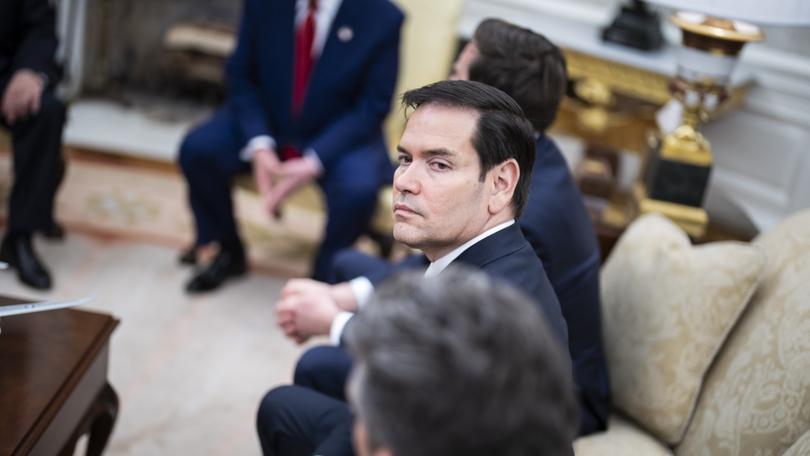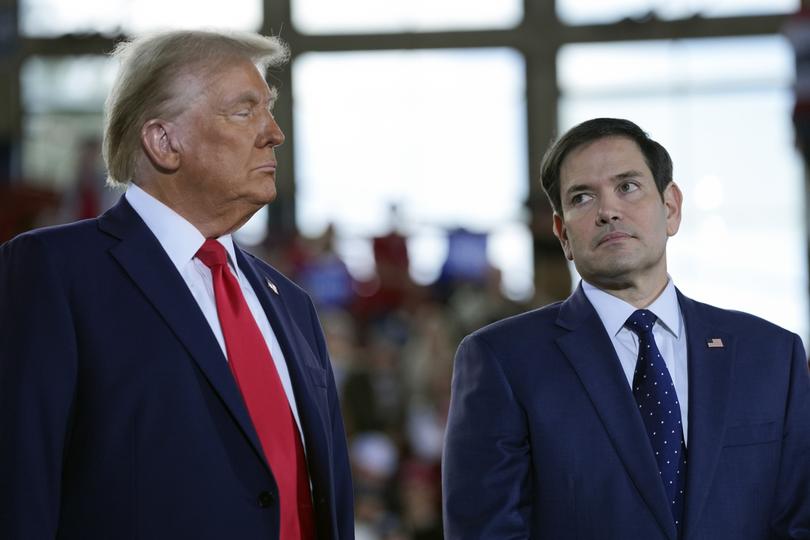Trump-era diplomacy reboot: Marco Rubio targets ‘radical ideologies’ in state dept. restructuring

Secretary of State Marco Rubio on Tuesday unveiled a plan to significantly reorganise the State Department, saying the redesign would reverse “decades of bloat and bureaucracy” and seek to eradicate what he suggested was an ingrained “radical political ideology.”
The proposed shake-up of the United States’ primary foreign policy institution coincides with the Trump Administration’s efforts to reorient the country on the world stage to align with the president’s “America First” agenda while cutting costs and downsizing staff across the Federal Government.
The effort targets some human rights programs and others focused on war crimes and democracy, according to internal documents shared with The Washington Post.
Sign up to The Nightly's newsletters.
Get the first look at the digital newspaper, curated daily stories and breaking headlines delivered to your inbox.
By continuing you agree to our Terms and Privacy Policy.As part of the plan, senior officials would submit to department leadership a path to reduce US-based staff by 15 per cent, according to the documents, potentially affecting hundreds of jobs, though there would be no immediate layoffs.
A senior State Department official, speaking on the condition of anonymity under ground rules set by the Administration, said Mr Rubio’s plan represents the first attempt “in decades” to reorganise the domestic structure of the nation’s oldest executive department.
Other officials left open the possibility that far greater downsizing could occur, affecting, potentially, tens of thousands of the department’s 80,000 employees globally, and numerous US consulates and facilities abroad.
The State Department has sent its reorganisation plans to the Senate Foreign Relations Committee and the House Foreign Affairs Committee, which provide oversight of the department. Lawmakers in both parties have raised concerns about major changes to congressional-mandated programs and agencies that the Trump Administration has signalled it wants to revamp or outright delete.
This plan includes the elimination of 132 offices and 700 positions, said a congressional aide who reviewed the documents. Many others would be transferred or “reorganised,” though such changes were not clearly explained, leaving questions about how the proposed shake-up would functionally alter things, the aide said. This person, like some others, spoke on the condition of anonymity to discuss the proposal.
Mr Rubio wrote on social media: “Region-specific functions will be consolidated to increase functionality, redundant offices will be removed, and non-statutory programs that are misaligned with America’s core national interests will cease to exist.” He did not specify which ones.
In an email to staff, Deputy Secretary of State Chris Landau said implementation would be led by an internal working group that would come up with “thoughtful plans” on adopting the changes by July 1.
President Donald Trump is a longtime critic of the State Department, dating at least to his first term in office.
He clashed early and often with Secretary of State Rex Tillerson and later, when US diplomats played key roles in the president’s first impeachment trial. It has been clear since Mr Trump’s election in November that his second Administration would target the department; the question was not whether cuts would happen but how big they would be.
The reorganisation plan announced Tuesday calls for sweeping change, but it is less radical than some purported proposals and the rampant speculation that spread among current and former State Department officials in recent weeks.
Tibor Nagy, a former Foreign Service officer who served as undersecretary for management until early April and who worked on reorganisation efforts, said he was pleased that the final plan did not include some of the more “drastic” steps that had been floated.
“It is planned, rational and logical instead of chaotic,” said Mr Nagy, who, since leaving office, has been critical of what he’s called the “chain saw” approach of Elon Musk’s US DOGE Service amid its efforts to slash the federal workforce.
Others were more pointed. It appears Mr Rubio tried to “wrest control of how the cuts came down” from DOGE, said Brett Bruen, a former State Department and National Security Council official in the Obama administration, but the plan announced Tuesday nevertheless is “designed to satiate the DOGE demand for cuts, irrespective of the damage to American interests.”

Democratic lawmakers criticised the reorganisation plan Tuesday, with Rep. Gregory W. Meeks (New York), the top Democrat on the House Foreign Affairs Committee, saying that the “proposed reorganisation of the State Department, developed with zero consultation with Congress, raises significant concerns about the future of American diplomacy, foreign policy, and global leadership.”
“The vital work left on Secretary Rubio’s cutting-room floor represents significant pillars of our foreign policy long supported by Democrats and Republicans alike, including former Senator Rubio, not ‘radical ideologies’ as he now claims,” Mr Meeks said in a statement.
Sen. Brian Schatz (Hawaii), the top Democrat on the Senate Appropriations subcommittee on state and foreign operations, which is responsible for drafting the State Department budget, also mentioned Mr Rubio’s history of support for multilateral foreign policy.
“Then-Senator Rubio once asked, ‘If America stops leading, who will fill the vacuum we leave behind?’” Senator Schatz said.
“What remains unclear is whether or not Secretary Rubio, my former colleague on the Senate Foreign Relations Committee, still shares this view. His current actions suggest that this is no longer the case.”
Among Republicans, the reception was warmer. Rep. Brian Mast (Florida), chairman of the House Foreign Affairs Committee and a Trump loyalist who has played a key role in spreading allegations about corruption at the US Agency for International Development, said the shake-up was overdue.
“Warfare and diplomacy in the 21st century are changing every day. Yet, bloat and bureaucracy keep the State Department from responding to those changes. This reorganisation will make the State Department leaner and meaner and ensure every dollar and diplomat puts America First,” Mr Mast said.
Over the weekend, a document circulated among current and former officials purported to be a draft executive order that outlined drastic changes, including the shuttering of the Bureau of African Affairs and numerous outposts across the continent. Mr Rubio distanced himself from that document, calling it a “hoax” and “fake news.”
The plan announced Tuesday did not cut the Bureau of African Affairs, a relief to many diplomats. But it did announce the demise of many others.
For instance, the position of undersecretary for civilian security, democracy and human rights would be eliminated, with some of the corresponding offices incorporated into a “reimagined” office for foreign and humanitarian affairs, the documents show.
The offices of global criminal justice, a body that seeks to investigate war crimes, and conflict and stabilisation operations, which seek to prevent wars, would be closed, according to the documents.
Foreign aid advocates said the proposed cuts are less severe than many feared, but attributed that to how grim initial expectations were as a result of the stunning dismantlement of USAID earlier this year.
“It doesn’t seem horrible,” said one former USAID official, noting that most of the bureaus marked for elimination are being absorbed into other offices.
Still, Washington’s food assistance programs will have fewer resources and less bandwidth as they are folded into the office of the director of foreign assistance and human rights, said aid experts.
“My biggest concern is that there is no stand-alone humanitarian assistance bureau,” said the former USAID official.
“The same person who is supposed to be coordinating all foreign assistance across the department is also supposed to be the chief humanitarian for the US government, responsible for getting billions of dollars of assistance to the most difficult operating environments with likely 95 per cent less staff than before.”
State Department spokeswoman Tammy Bruce said that in cases where a bureau is “folded into another larger bureau” it “doesn’t mean that it’s gone or we don’t care.”
There were some apparent areas of growth. A new bureau of emerging threats would be created to focus on cybersecurity and the proliferation of artificial intelligence, among other areas. The proposed bureau would represent a rare instance of expanding the department’s capacity.
One former official, speaking broadly about the reorganisation plan, warned that “shuffling things around doesn’t always fix the underlying issue.” The cuts could “kill a lot of expertise,” the official added. “As with all reorganisations, is the juice worth the squeeze?”
Abigail Hauslohner contributed to this report.
© 2025 , The Washington Post
